Analysis
The subject of the Magdalen as a sinner and fallen woman returned to the path of virtue by Jesus was very popular in the 16th century, allowing artists to combine eroticism and religion without courting scandal. Titian's version of the subject shows her at a moment of elation and deep repentance, with tears in her eyes (referring to her washing Jesus' feet and drying them with her hair) and her gaze raised heavenwards. Erotic though it is, as Vasari notes, her nudity refers to the medieval legend that her clothes fell apart during the thirty years she spent repenting in the desert after the Ascension of Jesus. Indeed, most of the many depictions of the subject in art showed the Magdalen with no clothing at all, or just a loose wrap, as in Titian's later treatment. According to popular works such as the Golden Legend , she spent her last years naked and alone in a hermitage in the mountains of Provence, fed only by the singing angels who visited her daily. Thus her lack of clothing symbolises her abandonment of jewels, gold and worldly goods to her faith in Christ. Additionally, the Magdalen's golden hair, fleshy body, and full lips correspond with the Renaissance beauty standards at the time. [2]
At the end of the Middle Ages a tradition grew up that she had grown a "suit" of hair all over her body except for her face, hands and feet. This is thought to have originated in liturgical drama and is often depicted in South German art. Titian's depiction achieves a similar effect and may well recall the German treatments.
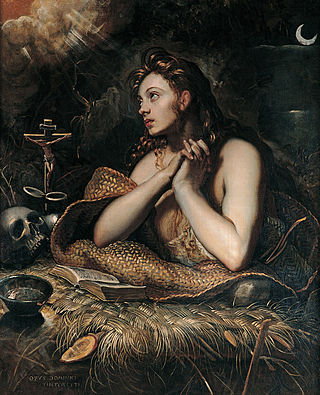
Mary Magdalene was a woman who, according to the four canonical gospels, traveled with Jesus as one of his followers and was a witness to his crucifixion and resurrection. She is mentioned by name twelve times in the canonical gospels, more than most of the apostles and more than any other woman in the gospels, other than Jesus's family. Mary's epithet Magdalene may be a toponymic surname, meaning that she came from the town of Magdala, a fishing town on the western shore of the Sea of Galilee in Roman Judea.
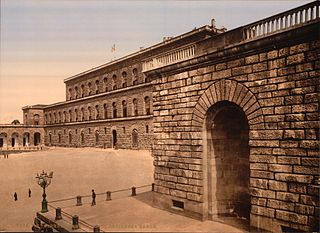
The Palazzo Pitti, in English sometimes called the Pitti Palace, is a vast, mainly Renaissance, palace in Florence, Italy. It is situated on the south side of the River Arno, a short distance from the Ponte Vecchio. The core of the present palazzo dates from 1458 and was originally the town residence of Luca Pitti, an ambitious Florentine banker.

The Venus of Urbino is an oil painting by Italian painter Titian, depicting a nude young woman, traditionally identified with the goddess Venus, reclining on a couch or bed in the sumptuous surroundings of a Renaissance palace. Work on the painting seems to have begun anywhere from 1532 or 1534, and was perhaps completed in 1534, but not sold until 1538. It is currently held in the Galleria degli Uffizi in Florence.
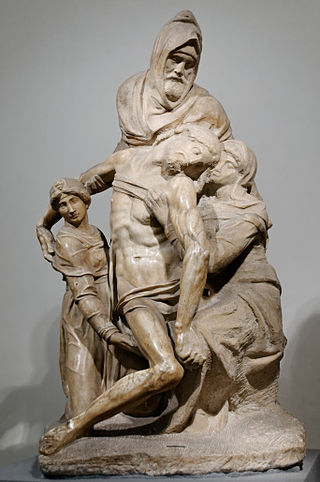
The Deposition is a marble sculpture by the Italian High Renaissance master Michelangelo. The sculpture, on which Michelangelo worked between 1547 and 1555, depicts four figures: the dead body of Jesus Christ, newly taken down from the Cross, Nicodemus, Mary Magdalene and the Virgin Mary. The sculpture is housed in the Museo dell'Opera del Duomo in Florence and is therefore also known as the Florentine Pietà.
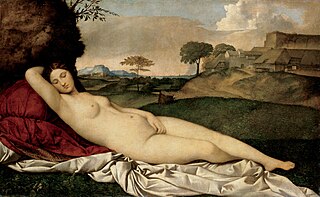
The Sleeping Venus, also known as the Dresden Venus, is a painting traditionally attributed to the Italian Renaissance painter Giorgione, although it has long been widely thought that Titian completed it after Giorgione's death in 1510. The landscape and sky are generally accepted to be mainly by Titian. In the 21st century, much scholarly opinion has shifted further, to see the nude figure of Venus as also painted by Titian, leaving Giorgione's contribution uncertain. It is in the Gemäldegalerie, Dresden. After World War II, the painting was briefly in possession of the Soviet Union.

Mary Magdalen in Ecstasy (1606) is a painting by the Italian baroque artist Michelangelo Merisi da Caravaggio (1571-1610). What is believed to be the authentic version of the painting was discovered in a private collection in 2014; the painting was previously only known to art historians through a number of copies made by followers of the artist.

The Madonna del cardellino or Madonna of the Goldfinch is an oil on wood painting by the Italian Renaissance artist Raphael, from c. 1505–1506. A 10-year restoration process was completed in 2008, after which the painting was returned to its home at the Uffizi in Florence. During the restoration, an antique copy replaced the painting in the gallery.
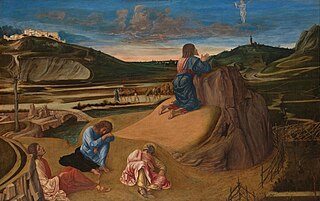
The Agony in the Garden is an early painting by the Italian Renaissance master Giovanni Bellini, who created it ca.1459–1465. It is a tempera painting on panel and is now in the National Gallery, London.

Penitent Magdalene is a 16th-century oil on canvas painting by Italian Baroque painter Caravaggio. The painting portrays a repentant Mary Magdalene bowed in penitent sorrow as she leaves behind her dissolute life, its trappings abandoned beside her. At the time of its completion, ca. 1594–1595, the painting was unconventional for its contemporary realism and departure from traditional Magdalene iconography. It has invited both criticism and praise, with speculation even into the 21st century as to Caravaggio's intentions. The work hangs in the Doria Pamphilj Gallery in Rome.

The Magdalen Reading is one of three surviving fragments of a large mid-15th-century oil-on-panel altarpiece by the Early Netherlandish painter Rogier van der Weyden. The panel, originally oak, was completed some time between 1435 and 1438 and has been in the National Gallery, London since 1860. It shows a woman with the pale skin, high cheek bones and oval eyelids typical of the idealised portraits of noble women of the period. She is identifiable as the Magdalen from the jar of ointment placed in the foreground, which is her traditional attribute in Christian art. She is presented as completely absorbed in her reading, a model of the contemplative life, repentant and absolved of past sins. In Catholic tradition the Magdalen was conflated with both Mary of Bethany who anointed the feet of Jesus with oil and the unnamed "sinner" of Luke 7:36–50. Iconography of the Magdalen commonly shows her with a book, in a moment of reflection, in tears, or with eyes averted.

The Lamentation over the Dead Christ is a painting of the common subject of the Lamentation of Christ by the Italian Renaissance painter Pietro Perugino, executed in 1495 and now in the Galleria Palatina of Palazzo Pitti, Florence, Italy.

The Tribute Money is a panel painting in oils of 1516 by the Italian late Renaissance artist Titian, now in the Gemäldegalerie Alte Meister in Dresden, Germany. It depicts Christ and a Pharisee at the moment in the Gospels when Christ is shown a coin and says "Render unto Caesar the things that are Caesar's, and unto God the things that are God's". It is signed "Ticianus F.[ecit]", painted on the trim of the left side of the Pharisee's collar.

Woman with a Mirror is an oil on canvas painting by Titian, dated to c. 1515. It is held in the Musée du Louvre, in Paris.

Portrait of Laura Dianti is a c. 1520–25 painting by Titian, now held in the H. Kisters Collection at Kreuzlingen. It is signed "TICI/ANVS F." The portrait features Laura Dianti, mistress, and later wife of the Duke of Ferrara Alfonso I d'Este and an African page. She is dressed in a blue dress with her hand placed on the shoulder of her page as he looks up at her. The painting is possibly associated with a portrait of Alfonso I d'Este. It is also controversial in that it was used to contest the legitimacy of the pair's marriage after the duke's death. It traveled through many locations and was initially thought to be one of many copies until a restoration uncovered a signature by Titian.

The Penitent Magdalene is a 1560s oil painting by Titian of Saint Mary Magdalene, now in the Hermitage Museum in Saint Petersburg, Russia. The painting depicts Mary Magdalene who spent many years in the desert atoning for her sins The artwork was acquired from the Barbarigo Gallery in Venice, Italy and entered the Hermitage in 1850. Titian had kept this painting for himself and after his death Titian's son sold it along with other paintings to Cristoforo Barbarigo.

La Bella is a portrait of a woman by Titian in the Palazzo Pitti in Florence. The painting shows the subject with the ideal proportions for Renaissance women. In parallel the stringent composition corresponds to Titian's real portraits. The work can be dated by a letter about "that portrait of that woman in a blue dress" in May 1536.

Magdalene with the Smoking Flame is a c. 1640 oil-on-canvas depiction of Mary Magdalene by French Baroque painter Georges de La Tour. Two versions of this painting exist, one in the Los Angeles County Museum of Art and the other in the Louvre Museum.

The Conversion of Mary Magdalene is an oil painting, an early work by the Italian Renaissance artist based in Venice, Paolo Veronese (1528–1588). He was known for his sumptuous paintings with a dramatic and colourful style. Dating from circa 1545–1548, when he was still in his teens, the painting was probably commissioned by a noble patron in Verona. It is now in the National Gallery in London.

Girl in a Fur is an oil on canvas painting by Titian, from 1536-1538. It is held in the Kunsthistorisches Museum, in Vienna. It depicts the same female model that he used in La Bella and Venus of Urbino.
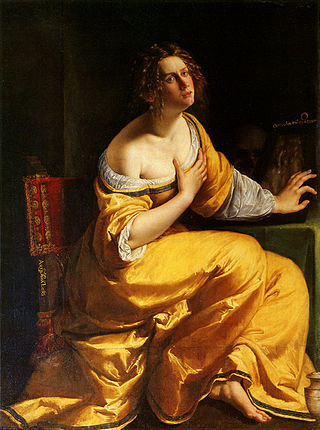
Penitent Magdalene is a 1616–1618 painting by the Italian baroque artist Artemisia Gentileschi. This painting hangs in the Pitti Palace in Florence. The subject is the biblical figure Mary Magdalene, but the painting references another biblical woman, Mary, the sister of Lazarus. This painting was likely painted during Gentileschi's Florentine period.




















